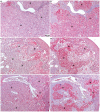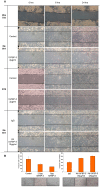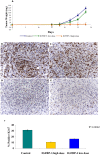Insulin-like-growth-factor-binding-protein-3 (IGFBP-3) contrasts melanoma progression in vitro and in vivo
- PMID: 24905466
- PMCID: PMC4048209
- DOI: 10.1371/journal.pone.0098641
Insulin-like-growth-factor-binding-protein-3 (IGFBP-3) contrasts melanoma progression in vitro and in vivo
Abstract
Insulin-like-factor-binding-protein 3 (IGFBP-3) is known to modulate the activity of insulin-like growth factors (IGFs) besides having a number of IGF-independent effects on cell growth and survival. IGFBP-3 has been reported to decrease significantly in the blood serum of patients affected by certain cancers. In the present work, we have evaluated the levels of IGFBP-3 in the blood serum and tissues of patients affected by cutaneous melanoma, showing that loss of IGFBP-3 from both is strongly correlated with disease progression and reduced survival. In vitro treatment with IGFBP-3 of human and murine metastatic melanoma cell lines specifically inhibited the cells' migratory and invasive behaviour, inducing up-regulation of melanocytic differentiation markers such as tyrosinase activity and melanin content. A molecular analysis of the cellular pathways transducing the effect of IGFBP-3 implicated the Akt-GSK3β axis. Moreover, administration of IGFBP-3 in vivo to SCID mice inoculated with human metastatic melanoma cells strongly reduced or completely inhibited tumor growth. In summary, IGFBP-3 appears to exert a specific inhibitory effect on melanoma growth and dissemination, suggesting that it may qualify as a useful therapeutic agent in melanomas and perhaps other cancers, at the least as a valid adjuvant therapy during treatment with conventional anti-tumoral drugs.
Conflict of interest statement
Figures









Similar articles
-
IGFBP-3 inhibits Wnt signaling in metastatic melanoma cells.Mol Carcinog. 2017 Feb;56(2):681-693. doi: 10.1002/mc.22525. Epub 2016 Jul 27. Mol Carcinog. 2017. PMID: 27377812 Free PMC article.
-
Biological effects induced by insulin-like growth factor binding protein 3 (IGFBP-3) in malignant melanoma.Int J Cancer. 2010 Jan 15;126(2):350-61. doi: 10.1002/ijc.24727. Int J Cancer. 2010. PMID: 19588500
-
Insulin-like growth factor binding protein-4 and -5 modulate ligand-dependent estrogen receptor-α activation in breast cancer cells in an IGF-independent manner.Cell Signal. 2013 Jun;25(6):1395-402. doi: 10.1016/j.cellsig.2013.02.018. Epub 2013 Mar 14. Cell Signal. 2013. PMID: 23499909
-
Molecular regulation of insulin-like growth factor-I and its principal binding protein, IGFBP-3.Prog Nucleic Acid Res Mol Biol. 1998;60:195-265. doi: 10.1016/s0079-6603(08)60894-6. Prog Nucleic Acid Res Mol Biol. 1998. PMID: 9594576 Review.
-
IGFBP-3/IGFBP-3 Receptor System as an Anti-Tumor and Anti-Metastatic Signaling in Cancer.Cells. 2020 May 20;9(5):1261. doi: 10.3390/cells9051261. Cells. 2020. PMID: 32443727 Free PMC article. Review.
Cited by
-
Insulin-like growth factor binding protein 5 (IGFBP5) functions as a tumor suppressor in human melanoma cells.Oncotarget. 2015 Aug 21;6(24):20636-49. doi: 10.18632/oncotarget.4114. Oncotarget. 2015. PMID: 26010068 Free PMC article.
-
Elevated Serum IGFBP-2 and CTGF Levels Are Associated with Disease Activity in Patients with Dermatomyositis.Dis Markers. 2022 Mar 20;2022:9223883. doi: 10.1155/2022/9223883. eCollection 2022. Dis Markers. 2022. PMID: 35356065 Free PMC article.
-
The Role of Adipokines in the Pathologies of the Central Nervous System.Int J Mol Sci. 2023 Sep 28;24(19):14684. doi: 10.3390/ijms241914684. Int J Mol Sci. 2023. PMID: 37834128 Free PMC article. Review.
-
Low Energy Availability with and without a High-Protein Diet Suppresses Bone Formation and Increases Bone Resorption in Men: A Randomized Controlled Pilot Study.Nutrients. 2021 Feb 28;13(3):802. doi: 10.3390/nu13030802. Nutrients. 2021. PMID: 33671093 Free PMC article. Clinical Trial.
-
Response to "Insulin-like growth factor 1 receptor signaling via Akt: a general therapeutic target in neurocutaneous melanocytosis?".Neuro Oncol. 2016 Jan;18(1):143-4. doi: 10.1093/neuonc/nov290. Neuro Oncol. 2016. PMID: 26667140 Free PMC article. No abstract available.
References
-
- Manola J, Atkins M, Ibrahim J, Kirkwood J (2000) Prognostic factors in metastatic melanoma: a pooled analysis of Eastern Cooperative Oncology Group trials. J Clin Oncol. Nov 15 18(22): 3782–93. - PubMed
-
- Ries LA, Wingo PA, Miller DS, Howe HL, Weir HK, et al. (2000) The annual report to the nation on the status of cancer, 1973–1997, with a special section on colorectal cancer. Cancer 88: 2398–2424. - PubMed
-
- Lomas J, Martin-Duque P, Pons M, Quintanilla M (2008) The genetics of malignant melanoma. Front Biosci 13: 5071–5093. - PubMed
-
- Hwa V, Oh Y, Rosenfeld RG (1999) The insulin-like growth factor-binding protein (IGFBP) superfamily. Endocr Rev. 20(6): 761–87. - PubMed
Publication types
MeSH terms
Substances
LinkOut - more resources
Full Text Sources
Other Literature Sources
Medical
Molecular Biology Databases
Miscellaneous

